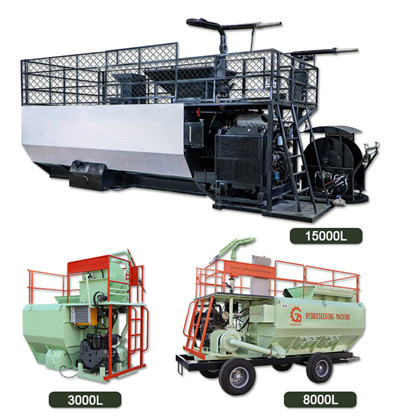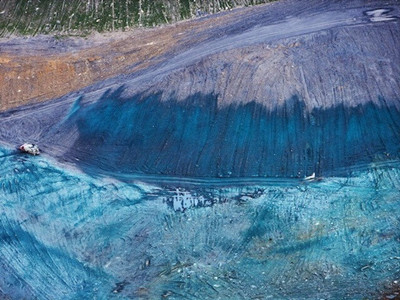hydroseeding machine for re-greening mine
2021-02-08 17:24:00
hydroseeding machine for re-greening mine
The greening of mines and the restoration of mining areas mean the restoration of the pollution of abandoned mining land and the reuse of land resources. Hydroseeding machine is an important equipment for mine greening. During the mining process, a large amount of land that cannot be used without treatment is produced, which is also called mining wasteland. There are various pollution caused by production in the wasteland.

Classification of abandoned mines:
1. Waste rock accumulation site formed by stripping topsoil, mined rock fragments and low-grade ore.
2. The mined-out area and subsidence area left after the mining of the ore body is the mining wasteland formed.
3. Tailings wasteland formed by the accumulation of tailings after mining ore and selecting concentrate.
4. Land that is first occupied and then abandoned, such as mining operations, mechanical facilities, ore auxiliary buildings, and road traffic.
Most of the mining wastelands are mainly polluted by heavy metals and acid drainage from mines, and the treatment content is mainly ecological restoration and pollution control. Mine pollution remediation is restricted by topography, climatic characteristics, hydrological conditions, soil physical, chemical and biological characteristics, topsoil conditions, potential pollution and other factors. Therefore, the selection of remediation technology and implementation schemes needs to consider the influence of various factors.

1. Slope treatment measures
The main work of slope treatment is to stabilize the slope. The task of this process is to remove dangerous rocks, lower slopes and cut slopes, make the cliffs without steps as possible as possible to form horizontal steps, and reduce the slope of the side slope below a safe angle to eliminate the hidden danger of collapse. Afterwards, the treated slope shall be re-greened to make it further stable. This step can be used to re-green the slope by using hydroseeding machine.
2. Tailings treatment measures
Re-development of tailings that occupies a large amount of land to increase the comprehensive utilization rate of tailings; develop large-scale, low-investment and marketable tailings to realize large-scale operation and resource utilization and commercialization of multi-variety development to make them waste Weibao has truly become a part of economic commodities. The waste water in the tailings dam must also be treated to meet the standards, so that the flotation waste water can be reused and zero discharged after appropriate purification. For mines in untreated goafs, abandoned roadways and chambers, using underground goafs to discharge tailings is a way to dispose of tailings.
3. Soil base improvement
The key to ecological damage caused by mining is land degradation, that is, the change of soil factors, that is, the deterioration of the physical and chemical properties of the soil in the abandoned land, the loss of nutrients and the increase of toxic and harmful substances in the soil. Therefore, soil improvement is an important part of ecological restoration of abandoned mines. The measures that can be taken include: (1) Measures for taking soil from other places: without damaging the soil from other places, take appropriate amount of soil and move it to the severely damaged part of the mine, and plant plants on the soil through absorption, volatilization, and root The effects of filtration, degradation and stabilization can repair damaged soil. (2) Measures for reconstruction of abandoned land Before the topsoil reconstruction, try to infuse the mud to wrap the waste residue, and then pave a layer of clay compaction to create an artificial water barrier, reduce the underwater seepage of the ground and prevent the highly toxic elements in the waste residue. freed. (3) Soil fertilization and improvement measures: adding substances to improve the physical and chemical properties of the soil, thereby shortening the process of vegetation succession and speeding up the ecological reconstruction of abandoned mines.
4. Phytoremediation of heavy metal pollution in mines
Heavy metal-tolerant plants can not only tolerate heavy metal toxicity, but also adapt to harsh environments such as barren wasteland and poor soil structure. Some tolerant plants can also accumulate high concentrations of heavy metals, so they are widely used in the restoration of heavy metal contaminated land. Considering the ecological problems that may be caused by introduction and the adaptability of native plants to local climatic conditions, it is necessary to screen for heavy metal-tolerant plants locally. This process can also be used to introduce heavy metal-tolerant plants by using hydroseeding machine.
5. Recovery of water resources in mines
The damage to water in mining is manifested in the impact on surface water and groundwater. The pollution of surface water and groundwater can be removed by constructing artificial wetlands and tolerating the effects of plants and microorganisms. Another aspect is the lack of surface water and the drop of groundwater level caused by excessive water extraction. This requires proper water diversion to alleviate the pressure of water shortage and build a water storage system to gradually solve this problem.
6. Microbial remediation measures
The ecological restoration of mine wasteland is not enough to restore the soil and vegetation. It is also necessary to restore the microbial community in the wasteland. Only by perfecting the functions of the ecosystem can the restored wasteland ecosystem be maintained naturally. The restoration of the microbial community should not only restore the original community in the area, but also inoculate other microorganisms to remove or reduce pollutants. The following two types of microbial inoculation can be considered: one is anti-pollution bacteria, some of these bacteria can take pollutants as their own nutrients, decompose pollutants into non-polluting substances, or convert highly toxic substances into low toxicity Substance; The second is the microorganisms that help plants absorb nutrients. Some microorganisms can not only survive under high pollution conditions, but also provide nutrients for plant growth, such as fixing nitrogen and phosphorus, and improving the microenvironment.



